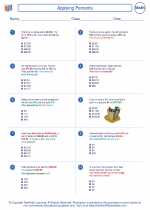One-Dimensional
Definition: In mathematics, "one-dimensional" refers to a space that has only one dimension, or a space that can be measured along a single line. It is often represented on a number line, where points are aligned in a single direction.
Concepts and Examples:
1. Number Line: A number line is a common example of a one-dimensional space. It extends infinitely in both positive and negative directions, and any point on the line can be represented by a single number.
2. Position and Distance: In one-dimensional space, the position of a point can be described using a single coordinate, typically a real number. The distance between two points on a number line is simply the absolute value of the difference between their coordinates.
3. Motion and Direction: Movement in one-dimensional space involves changes along a single axis. It can be represented as forward or backward motion along the number line, depending on the change in position.
Study Guide:
To understand the concept of one-dimensional space, consider the following study guide:
1. Number Line: Practice plotting points and identifying their positions on a number line. Understand how to represent positive and negative numbers on the line.
2. Distance and Coordinates: Work on problems involving the calculation of distances between points on a number line. Practice finding coordinates of points and understanding their significance in one-dimensional space.
3. Motion and Direction: Explore scenarios involving movement along a number line. Solve problems related to changes in position, distance traveled, and direction of motion.
4. Real-World Applications: Look for real-life examples of one-dimensional space, such as distance traveled along a straight road or position on a linear scale.
.
◂Math Worksheets and Study Guides Seventh Grade. Applying Percents

 Worksheet/Answer key
Worksheet/Answer key
 Worksheet/Answer key
Worksheet/Answer key
 Worksheet/Answer key
Worksheet/Answer key
